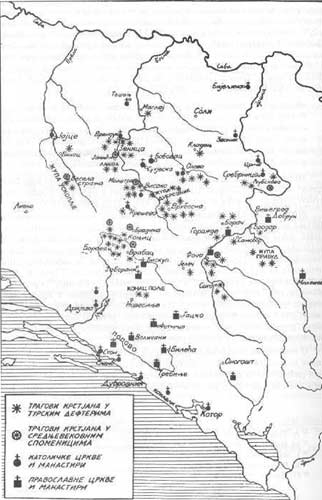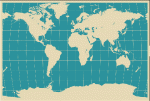Web catalog
Most read
Most read last 7 days
Most Discussed
Top rated
Statistics
- Total registered users: 10023
- Total articles: 23656
- Total comments: 2087
- Last entry: Kebo presenting evidence that Izetbegovic brought mujahideen to Bosnia
- Last update: 11.01.2019. 23:44
The Ottomans and Islam
Written 27.11.2009. 12:51
 The Ottoman invasion was unleashed towards Bosnia, but Bosnian aristocrats at the end of the 14th and the beginning of the 15th century, such as Hrvoje Vukcic Hrvatinic and Stjepan Kosaca, were almost solely preoccupied with their parochial power games and preservation of influence spheres. The logical corollary of such an attitude was their willingness to side with those that could offer them a power sharing arrangement, and ensure rule over their "cantons". The aristocrats's ideology was a natural concommitant of an age of violence, and as such, their fight for "cantonisation" was merciless32 (see map 20 and pictures 31 and 32). One cannot overlook a striking resemblance to the current fight for the creation of national republics and autonomous provinces. The Ottomans were received by the nobility as a welcomed ally in the effort to consolidate the newfound power. Hrvoje Vukcic Hrvatinic wooed the Ottomans for help in his war against Sigismund of Luxembourg, a long time before the fall of Bosnia.
The Ottoman invasion was unleashed towards Bosnia, but Bosnian aristocrats at the end of the 14th and the beginning of the 15th century, such as Hrvoje Vukcic Hrvatinic and Stjepan Kosaca, were almost solely preoccupied with their parochial power games and preservation of influence spheres. The logical corollary of such an attitude was their willingness to side with those that could offer them a power sharing arrangement, and ensure rule over their "cantons". The aristocrats's ideology was a natural concommitant of an age of violence, and as such, their fight for "cantonisation" was merciless32 (see map 20 and pictures 31 and 32). One cannot overlook a striking resemblance to the current fight for the creation of national republics and autonomous provinces. The Ottomans were received by the nobility as a welcomed ally in the effort to consolidate the newfound power. Hrvoje Vukcic Hrvatinic wooed the Ottomans for help in his war against Sigismund of Luxembourg, a long time before the fall of Bosnia.It is a historical truth that the Ottoman assault, assisted by islamised Bosnians, almost biologically destroyed the Croat nation. Some Bosnian Muslim historians maintain that the adherents of the "Bosnian church" converted to Islam, but the reality isn't so simple. Bosniak-Muslim scholar Hadzijahic avers that it is mostly the lower classes, peasants37 that converted to Islam, whilst the tribal organization of the cattle grazers was a barrier to the process. Croat historian Muzic rejects the hypothesis that Bosnian "heretics" converted to Islam en masse, because there were so few of them at the time-hence, no "masse" was available. He instead puts forward a speculation that it was the indigenous Pagans38 who converted, which is highly improbable due to the fact that Bosnia was already a Christianized country (and, not surprisingly, corroborated by early Ottoman population census ). Catholic writer Krunoslav Draganovic points out that Catholics were also converts to Islam39, and according to eminent Bosnian Croat historian, voluminous Franciscan author Dominik Mandic, the conversion of Catholics to Islam was particularly noticeable in times of increased persecution of Catholics, especially during the 17th century violent oppression, which can justifiably be labelled as the era of pogroms over Catholics. Despite all the doubts, it is clear that Bosniak-Muslims are in majority of cases the descendants of the indigenous population (although we shouldn't overlook the influx of outsiders from other parts of the empire, in relation to both the initial invasion, and the latter withdrawal of sizeable Muslim populations from liberated parts of Hungary, Croatia, Serbia and so on).
In the Bosnian Pashaluk, the Catholic population was treated as a particularly treacherous
denomination because their leader was the Pope - the arch-enemy of the Ottomans. With the adherents of the Orthodox faith (virtually non-existent in Bosnia proper on the eve of its fall), things were utterly different. Only two Orthodox sacral objects were registered in Bosnia in the 15th century, one near Visegrad on the Drina river, and the other in Milesevo.40 Map 23 shows the locations of churches in Bosnia at the time of the Ottoman arrival.
Musing over conspicuous absence of the Orthodox churches and monasteries, historian Ciro Truhelka remarked:
"In the region between Drina, Neretva and the Adriatic Sea and to the north to the river Sava, in the medieval times, there is absolutely no indication of existence of any Orthodox church or monastery. Only on the other side of the Neretva river, in the land of Hum (Hercegovina), which for a time was under Serb sovereignty, existed a church in Trebinje and a monastery at Ston. This last one was secularized after Dubrovnik purchased Ston and Rat in 1333, and the monks left for Jerusalem. The first Orthodox churches and monasteries only began to be built in the second half of the 16th Century. That is when a host of monasteries were built in eastern Bosnia: Tavna (Tamna), Ozren (1577), Papraca and Lomnica (1597), all in the same era and built by the same builders".42
As the Serbian Orthodox Church spread its influence as a part of the Ottoman state apparatus, the Croatian Catholics were able to seek refuge within the Orthodox faith. That is why many Catholics (especially in eastern Bosnia and Hercegovina) converted to Orthodox Christianity.43As a result of the Ottoman invasion, large Croat populations fled, and their land was settled by Orthodox Wallachians as loyal subjects of the Ottoman empire. The sturdy cattle grazers, but some of them also farmers, they were granted land for their service in the Ottoman army. The Ottoman onslaught changed the demographic structure of Bosnia: those Catholics that converted to the Orthodox faith, as well as Orthodox Wallachian settlers, eventually, through the assimilative sociocultural activities of the Serbian Orthodox church, have become a part of the Serb nation.44 A change in Bosnian dialects is also a byproduct of the demographic changes (see maps 4a, b, and c). With the settlement of the Wallachians and their eastern-hercegovinian dialect the compact region of western stokavian dialect was broken up. The widespread use of the new dialect is easily observed in majority Serb areas. Even the dialects chart of the pre-Ottoman and Ottoman times thus shows that Orthodoxy came to Bosnia as a result of the Ottoman conquest. The intrusion of the new dialect and Orthodoxy into Bosnia continued towards the Croatia proper regions where sudden demographic changes took place, which is supported by the decline of the old Croatian "cakavian" sub-dialect. (map 3, maps 4a, b and c). We can thus agree that sophisticated analyses of demographic movements and dialects before and after the arrival of the Ottomans definitely puts the theory of the Serb character of medieval Bosnia to rest.
























































 Kontaktirajte nas
Kontaktirajte nas
No comments